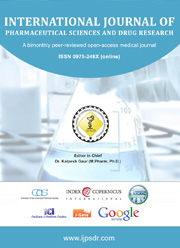In silico analysis of anti-inflammatory and anticancer properties of bioactive compounds from Pancratium triflorum (Roxb)
DOI:
https://doi.org/10.25004/IJPSDR.2024.160213Keywords:
Pancratium, Auto dock, anticancer, anti-inflammatoryAbstract
Herbal remedies with medicinal properties have been utilized in Asian countries for centuries. Recently, Pancratium triflorum Roxb., also known as the forest spider lily, has captured the attention of researchers due to its potential therapeutic benefits. This plant produces white flowers and contains several important phytochemicals, including Lycorine, citrate, Gallic acid, Ellagic acid, Quercetin, and Kaempferol. Molecular docking, a computer simulation technique, has been used to identify potential drug candidates that can bind effectively to the active site of a protein. This study explored the anti-inflammatory and anticancer properties of Pancratium triflorum Roxb.'s Phyto-constituents using molecular docking with Auto dock 4.2.6. The study focused on the Vioxx-bound human Cox2 receptor and the Tyrosine kinase receptor bound to Gliteritinib. Standard ligands were used for redocking, and the Swiss ADME software was employed for bioavailability prediction to validate the findings. The results showed that Lycorine and Crinine have excellent anti-inflammatory properties, while Kaempferol and Quercetin have promising anticancer properties. Further research is necessary, but these findings suggest that Pancratium triflorum Roxb. could be a valuable addition to the medical world. However, further research is required to validate these findings, and in vivo studies are needed to confirm the efficacy and safety of these phytochemicals as potential drug candidates.
Downloads
References
Paiva MJ, Nascimento GN, Damasceno IA, Santos TT, Silveira D. Pharmacological and toxicological effects of Amaryllidaceae. Brazilian Journal of Biology. 2023 15;83:277092. Available from. https://doi.org/10.1590/1519-6984.277092
Otari SS, Ghane SG. Bioactive Compounds and Biological Activities of the Genus Pancratium. Bioactive Compounds in the Storage Organs of Plants. 2023 Sep 4:1-8.
Mariarosaria Leporini, Giorgia Catinella, Maurizio Bruno, Tiziana Falco, Rosa Tundis, Monica R. Loizzo. "Investigating the Antiproliferative and Antioxidant Properties of Pancratium maritimum L. (Amaryllidaceae) Stems, Flowers, Bulbs, and Fruits Extracts".Evidence-Based Complementary and Alternative Medicine.2018;7. Available from https://doi.org/10.1155/2018/9301247
Pahwa R, Goyal A, Jialal I. Chronic Inflammation. [Updated 2023 August 7]. In: StatPearls [Internet]. Treasure Island (FL): StatPearls Publishing; 2024 Jan-. Available from: https://www.ncbi.nlm.nih.gov/books/NBK493173/
Leão RP, Cruz JV, da Costa GV, Cruz JN, Ferreira EFB, Silva RC, de Lima LR, Borges RS, Dos Santos GB, Santos CBR. Identification of New Rofecoxib-Based Cyclooxygenase-2 Inhibitors. A Bioinformatics Approach. Pharmaceuticals (Basel). 2020; 13:20. Available from doi: 10.3390/ph13090209.
Du Z, Lovly CM. Mechanisms of receptor tyrosine kinase activation in cancer. Mol Cancer. 2018 ;1:58.Avaliable from: https:// doi:10.1186/s12943-018-0782-4.
What is cancer? National Cancer Institute, [Updated: October 11, 2021] An official United States government website.2023 April 4 https://www.cancer.gov/about-website#:~:text=Cancer.
Olga De Castro, Salvatore Brullo, Paolo Colombo, Stephen Jury, Paolo De Luca, Antonietta Di Maio. Phylogenetic and biogeographical inferences for Pancratium, emphasizing the Mediterranean species based on plastid sequence data. Botanical Journal of the Linnean Society. 2012;170:12–28.Available from: https://doi.org/10.1111/j.1095-8339.2012.01268.x
Cedrón JC, Del Arco-Aguilar M, Estévez-Braun A, Ravelo AG. Chemistry and biology of Pancratium alkaloids. Alkaloids Chem Biol. 2010; 68:1-37. doi: 10.1016/s1099-4831(10)06801-x. PMID: 20334035.
Leporini M, Catinella G, Bruno M, Falco T, Tundis R, Loizzo MR. Investigating the Antiproliferative and Antioxidant Properties of Pancratium maritimum L. (Amaryllidaceae) Stems, Flowers, Bulbs, and Fruits Extracts. Evid Based Complement Alternat Med. 2018 September 30; 2018:9301247. Available from: https://doi.org/10.1155/2018/9301247.
Elgorashi EE. Phytochemistry and pharmacology of the family Amaryllidaceae: An overview of research at RCPGD. Natural Product Communications. 2019: 149:1934578 -19872929.Available from https://doi.org/10.1177/1934578X19872929.
Thomas Kurian. Molecular docking study of epigallocatechin gallate on flt3 in complex with Gliteritinib for anticancer activity. Asian journal of pharmaceutical and clinical research.2024:17:1: 5-7. Available. from10.22159/ajpcr.2024.v17i1.48733.
Yuriev E, Ramsland PA. Latest developments in molecular docking. 2010-2011 in review. J Mol Recognit. 2013;26:215-39. Available from: 10.1002/jmr.2266. PMID: 23526775.
Huey R, Morris GM, Forli S. Using AutoDock4 and Auto Dock Vina with Auto Dock Tools: A Tutorial. California, USA: The Scripps Research Institute. Molecular Graphic Laboratory; 2012:5 -19.
Zappavigna S, Cossu AM, Grimaldi A, Bocchetti M, Ferraro GA, Nicoletti GF, Filosa R, Caraglia M. Anti-Inflammatory Drugs as Anticancer Agents. Int J Mol Sci. 2020 ;21(7):2605. Available from doi: 10.3390/ijms21072605.
Johnson M, Maharaja P, Janakiraman N, Adaikala Raj G, Menezes IRA, da Costa JGM, Verde LCL, Coutinho HDM. Pancratium triflorum Roxb. (Amaryllidaceae) and Molineria trichocarpa (Wight) N.P. Balakr (Hypoxidaceae). Cytotoxic and antioxidant activities. Food Chem Toxicol. 2018;119:290-295. Available from 10.1016/j.fct.2018.02.055.
Gonzales AL, Huang SK-H, Sevilla UTA, Hsieh C-Y, Tsai P-W. In Silico Analysis of Anti-Inflammatory and Antioxidant Properties of Bioactive Compounds from Crescentia cujete L. Molecules. 2023; 28(8):3547.Available from. https://doi.org/10.3390/
Downloads
Published
Issue
Section
License
Copyright (c) 2024 Dr. THOMAS KURIAN THOMAS

This work is licensed under a Creative Commons Attribution 4.0 International License.


